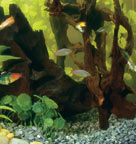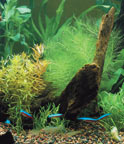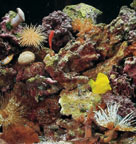The quality of aquatic life in your aquarium can be directly related to the quality of light. If the correct spectrum and intensity of light is not provided, the survival rate of your plants, corals, or invertebrates will be poor. When designing your aquarium lighting system, your goal should be to duplicate natural conditions. Thanks to recent advancements in lighting technology, this has become an easier task.
All lighting systems generate heat. The more powerful the lighting system, the greater the cooling requirements are likely to be. Regardless of the size or type of your lighting system, your aquarium should be located in a temperature-controlled room to help counterbalance radiant heat.
 Fish-only aquariums:
Fish-only aquariums:
Fish, artificial plants, decorative wood and/or ceramics
Recommended lighting system: Standard or a power compact fluorescent system.
A lighting system between 1 to 2 watts per gallon should be sufficient to simulate a day-night cycle in a fish-only aquarium. Because the requirements of a fish-only aquarium are forgiving, you can choose the spectrum of bulb that best suits your preference. Avoid the use of standard hardware store bulbs, however, which promote the growth of brown algae.
Freshwater planted aquariums:
Fish, live plants, decorative wood and/or ceramics
Recommended lighting system: Standard fluorescent, T5 HO, VHO, Power Compact, Metal Halide/HQI.

Most of the freshwater aquatic plants available on the market originally came from shallow areas of rivers in Central and South America. Though the water there is generally murky, the plants experience full-spectrum light. Depending on the specific species of plants you plan to acquire, and the depth of your tank, you will need a standard fluorescent lighting system between 2 and 5 watts per gallon. Purchase only plants which your lighting system will support.
The heat generated by most of the more powerful lighting systems required for live plants is considerable. If necessary, raise the fixture slightly above the cover to provide extra space to promote air circulation. A small cooling fan can be used to efficiently dissipate heat from the fixture.
 Saltwater reef aquariums:
Saltwater reef aquariums:
Fish, invertebrates, corals
Recommended lighting systems: T5 HO, VHO, Power Compact, Metal Halide/HQI
Many corals and invertebrates rely on light for a major portion of their nutrition, but the amount each type requires varies dramatically. In the wild, many corals come from depths of 15 to 65 feet where the light is extremely intense. However, many other corals have adapted to low-light conditions by hiding themselves within the reef for safety.
To correctly light a reef aquarium that is 24" deep or less, use a lighting system between 4 to 8 watts per gallon. Of course, you can relax requirements significantly by choosing to house only corals and invertebrates that require low levels of light, as well as non-photosynthetic invertebrates.
Many LPS (large polyp stony) corals are found at deeper depths, below 65 feet. Many corals at these depths fluoresce. They use blue light at these depths because of the ability of water to filter out the various spectrums. Because metal halide and other reef aquarium lighting systems generate substantial heat, they often require cooling. Hot air surrounding bulbs can be removed by fans. Removing this heat can increase the usefulness of your bulbs as heat adversely affects their lifespan. Ideally, the room temperature can be maintained at a level to counterbalance the radiant heat absorbed directly by the water. If not, a chiller may be needed.
Lighting Innovations
The most significant recent improvement in lighting systems is the advent of electronic ballasts that operate with less heat, and deliver much longer bulb life. Bulbs too have evolved. A wide range of light spectrums and intensities are now available, and in compact sizes that provide you far more set-up options. Most importantly, systems can now closely replicate the lighting that organisms experience in the wild.
Highlights of three new systems
- T-5 High Output (HO) Fluorescent Systems
High output, tiny size - the most advanced fluorescent lighting available!
With only a 5/8" diameter, thin T-5 HO Fluorescent bulbs produce almost twice the brightness of standard fluorescents. In addition to their brightness, you can also fit more of these slim bulbs into the same amount of space.
- Compact Fluorescent Lighting Systems
Bright, efficient, cool - great for every application
The next generation in fluorescent lighting, compact fluorescent systems utilize a twin-tube design, which results in much greater intensity and higher light outputs than standard fluorescent lamps. Their small size requires only half the space of standard fluorescent tubes, which makes these bulbs particularly appealing. Compact fluorescents have a low operating cost and produce significantly less heat than other intense light sources.
- VHO Fluorescent Lighting Systems
Super-bright and long-lasting - great for reef aquariums
VHO (very high output) fluorescent bulbs are similar in design to standard fluorescent lamps, but using a special ballast they produce three times more light than a standard fluorescent tube. Instead of using 4 to 6 standard fluorescent tubes to light your aquarium, you use only 2 VHO tubes! The spectrum of light produced by VHO bulbs is usually in the higher Kelvin range, so they are especially well-suited for reefs or live planted aquariums. When used with electronic ballasts, VHO tubes can last up to 12-18 months.
Lighting Overview
| Bulb Type |
Watts |

Bulb
Life
 |

Kelvin
Rating
 |
Benefits |
Limitations |
Typical Use |
 |
| |
Standard
Fluorescent |
15-40 |
6-18
months* |
3,000°-
20,000°K;
actinic |
Wide range of
colors, sizes;
aesthetic;
efficient; cool;
inexpensive |
Not ideally
suited for
photosynthetic
plants or
invertebrates |
Fresh or saltwater
community
aquarium or mini or
micro reef with
low light corals and
plants |
| |
 |
| |
T-5 HO
Fluorescent |
24-54 |
16-24
months |
6,000°-
11,000°K;
actinic |
Longevity;
high intensity;
small size; cool
running |
Not ideally
suited for
aquariums
more than
24" deep |
Reef less than 24"
deep; freshwater
planted |
| |
 |
| |
VHO
Fluorescent |
75-165 |
4-18
months* |
10,000°K;
actinic |
Large selection
of sizes; longer
bulb life than
standard
fluorescent |
Higher heat
- may require
a chiller |
Reefs less than 24"
deep; freshwater
planted |
| |
 |
| |
Compact
Fluorescent |
10-130 |
12-28
months |
5,000°-
10,000°K;
actinic |
Longevity;
high intensity;
wide spectrum
range;
compact |
May produce
higher heat -
may require a
chiller |
Reefs less than 24"
deep; freshwater
planted; marine
aquariums |
| |
 |
| |
Metal
Halide |
70-
1000 |
6-18
months |
4,000°-
20,000K° |
Highest
intensity; wide
spectrum
range |
Higher heat
- may require a
chiller; possible
UV radiation |
Reefs or freshwater
aquariums more
than 24" deep;
photosynthetic
corals and
invertebrates |
| |
 |
| |
LED Moon/
Lunar Light |
Approx
1 watt |
N/A (Not
a light,
but a
Light
Emitting
Diode) |
N/A** |
Low wattage;
recreates
nocturnal
lighting
conditions;
great for
viewing
nocturnal
inhabitants |
Requires
one unit per
every 24" of
aquarium
length |
Reef or freshwater
aquariums |
| |
*Depending upon ballast type
**Blue light in the 455-470 nm range depending on model
|